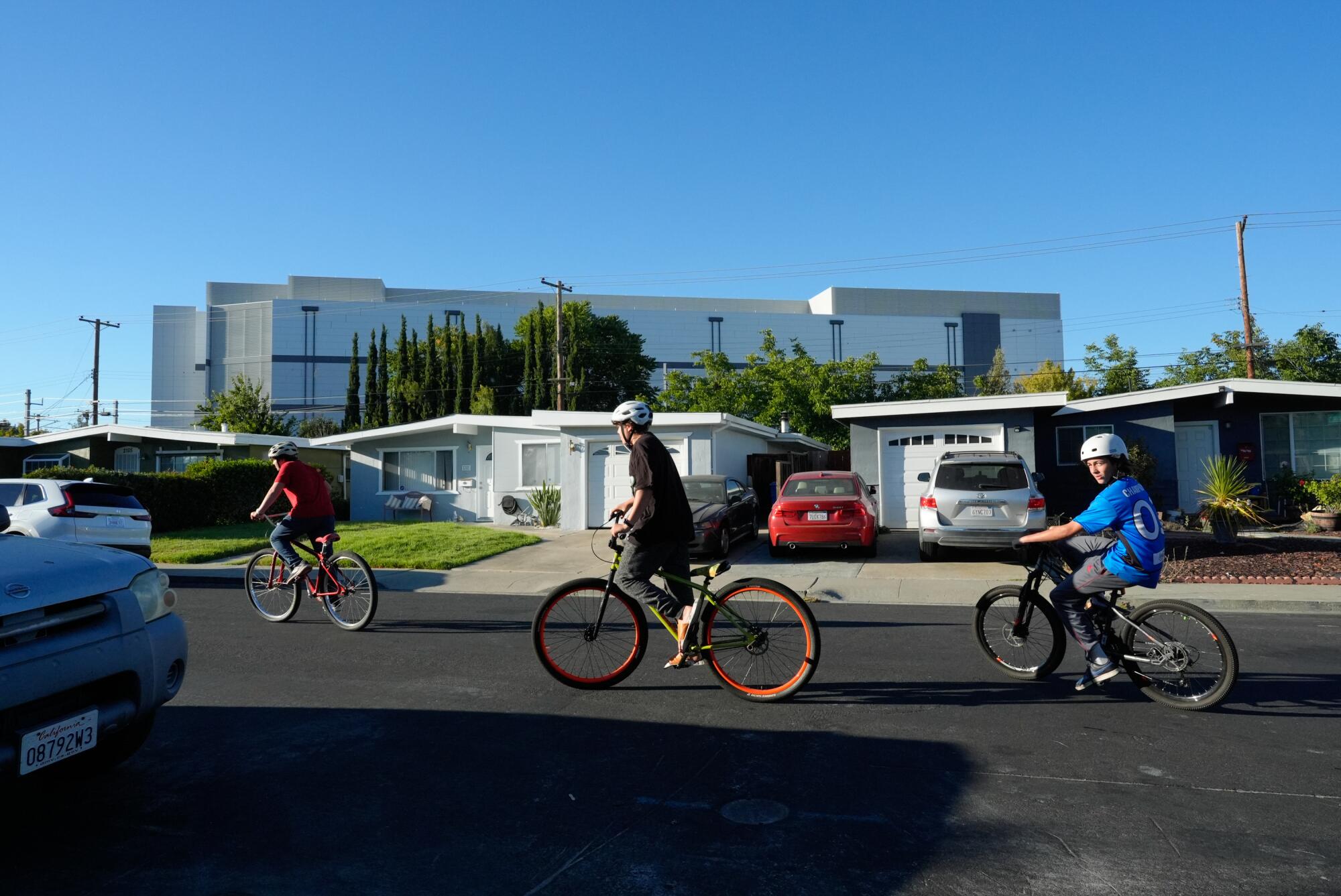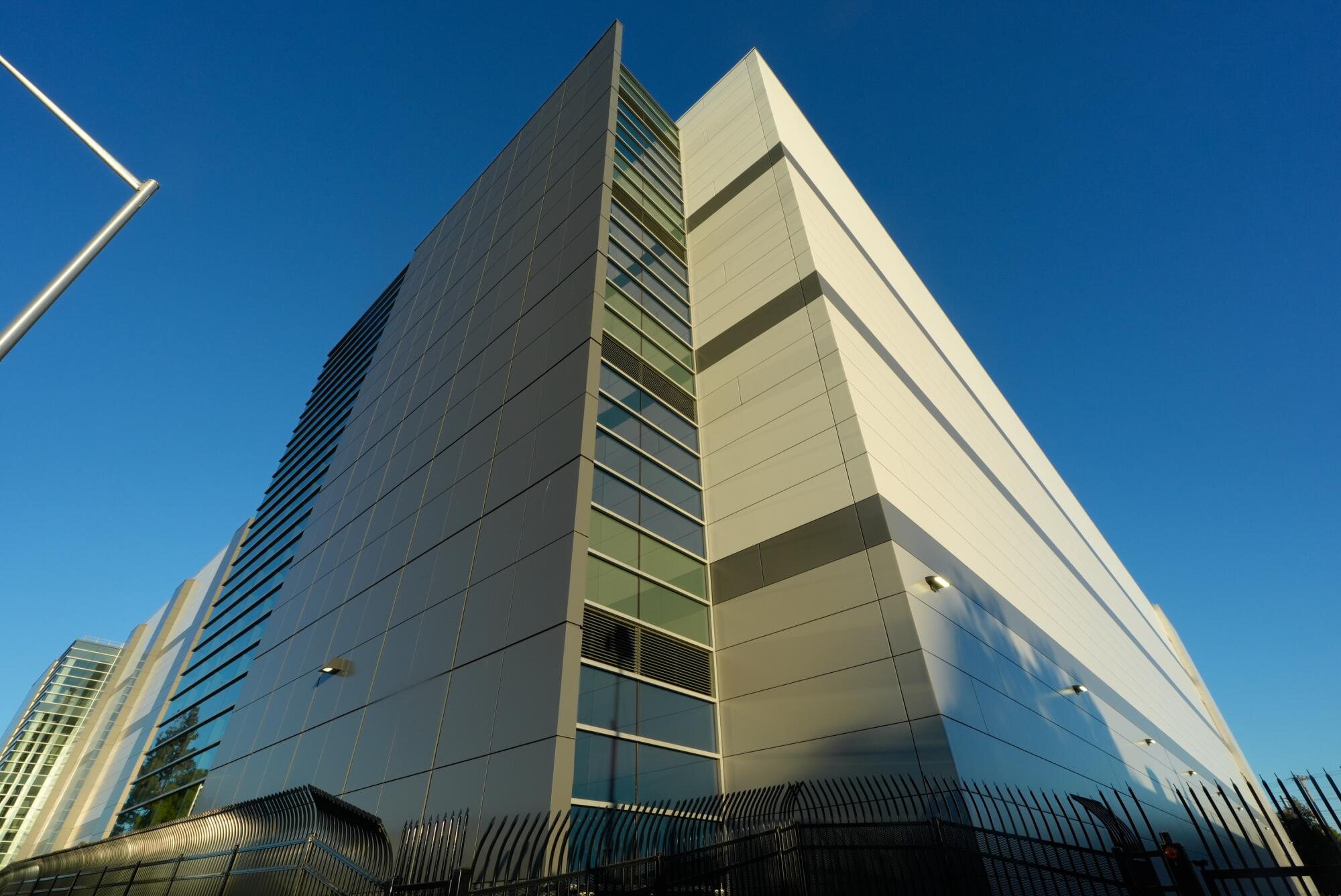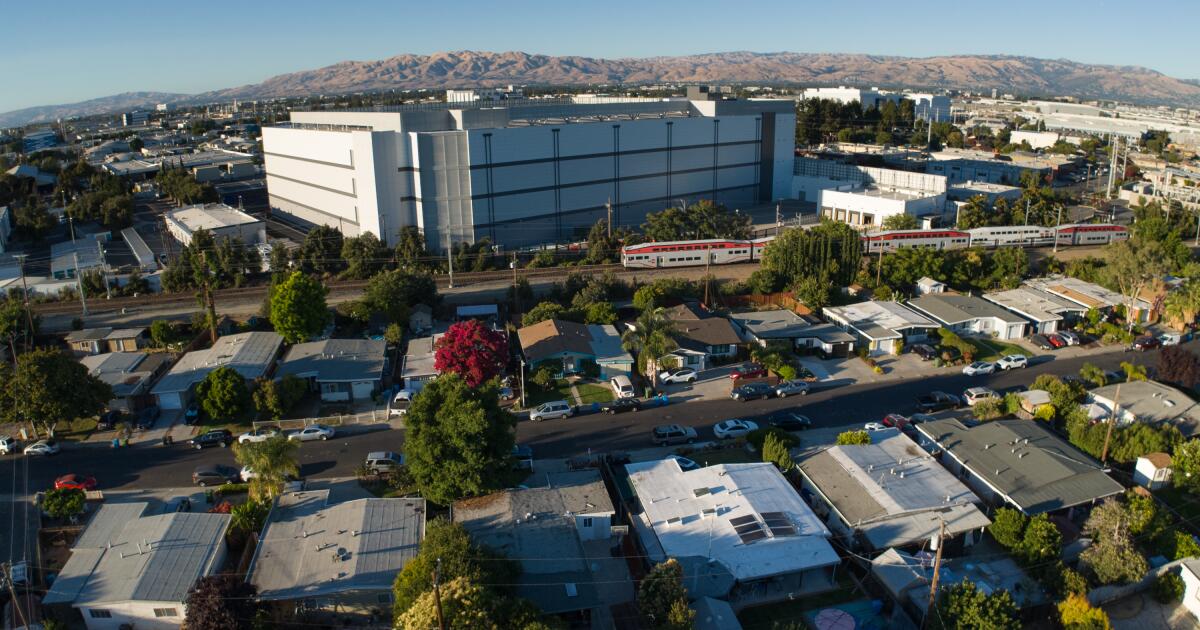Near the Salton Sea, a company plans to build a data center to support artificial intelligence that would cover land the size of 15 football fields and require power that could support 425,000 homes.
In Santa Clara — the heart of Silicon Valley — electric rates are rising as the municipal utility spends heavily on transmission lines and other infrastructure to accommodate the voracious power demand from more than 50 data centers, which now consume 60% of the city’s electricity.
And earlier this year, Pacific Gas & Electric told investors that its customers have proposed more than two dozen data centers, requiring 3.5 gigawatts of power — the output of three new nuclear reactors.
Vantage Data Center in Santa Clara is equipped with its own electrical substations.
(Paul Kuroda / For The Times)
While the benefits and risks of AI continue to be debated, one thing is clear: The technology is rapacious for power. Experts warn that the frenzy of data center construction could delay California’s transition away from fossil fuels and raise electric bills for everyone else. The data centers’ insatiable appetite for electricity, they say, also increases the risk of blackouts.
Even now, California is at the verge of not having enough power. An analysis of public data by the nonprofit GridClue ranks California 49th of the 50 states in resilience — or the ability to avoid blackouts by having more electricity available than homes and businesses need at peak hours.
“California is working itself into a precarious position,” said Thomas Popik, president of the Foundation for Resilient Societies, which created GridClue to educate the public on threats posed by increasing power use.
The state has already extended the lives of Pacific Gas & Electric Co.’s Diablo Canyon nuclear plant as well as some natural gas-fueled plants in an attempt to avoid blackouts on sweltering days when power use surges.
Worried that California could no longer predict its need for power because of fast-rising use, an association of locally run electricity providers called on state officials in May to immediately analyze how quickly demand was increasing.
The California Community Choice Assn. sent its letter to the state energy commission after officials had to revise their annual forecast of power demand upward because of skyrocketing use by Santa Clara’s dozens of data centers.

A large NTT data center rises in a Santa Clara neighborhood.
(Paul Kuroda / For The Times)
The facilities, giant warehouses of computer servers, have long been big power users. They support all that Americans do on the internet — from online shopping to streaming Netflix to watching influencers on TikTok.
But the specialized chips required for generative AI use far more electricity — and water — than those that support the typical internet search because they are designed to read through vast amounts of data.
A ChatGPT-powered search, according to the International Energy Agency, consumes 10 times the power as a search on Google without AI.
And because those new chips generate so much heat, more power and water is required to keep them cool.
“I’m just surprised that the state isn’t tracking this, with so much attention on power and water use here in California,” said Shaolei Ren, associate professor of electrical and computer engineering at UC Riverside.
Ren and his colleagues calculated that the global use of AI could require as much fresh water in 2027 as that now used by four to six countries the size of Denmark.
Driving the data center construction is money. Today’s stock market rewards companies that say they are investing in AI. Electric utilities profit as power use rises. And local governments benefit from the property taxes paid by data centers.

Transmission lines are reflected on the side of the NTT data center in Santa Clara.
(Paul Kuroda / For The Times)
Silicon Valley is the world’s epicenter of AI, with some of the biggest developers headquartered there, including Alphabet, Apple and Meta. OpenAI, the creator of ChatGPT, is based in San Francisco. Nvidia, the maker of chips needed for AI, operates from Santa Clara.
The big tech companies leading in AI, which also include Microsoft and Amazon, are spending billions to build new data centers around the world. They are also paying to rent space for their servers in so-called co-location data centers built by other companies.
In a Chicago suburb, a developer recently bought 55 homes so they could be razed to build a sprawling data center campus.
Energy officials in northern Virginia, which has more data centers than any other region in the world, have proposed a transmission line to shore up the grid that would depend on coal plants that had been expected to be shuttered.
In Oregon, Google and the city of The Dalles fought for 13 months to prevent the Oregonian from getting records of how much water the company’s data centers were consuming. The newspaper won the court case, learning the facilities drank up 29% of the city’s water.
By 2030, data centers could account for as much as 11% of U.S. power demand — up from 3% now, according to analysts at Goldman Sachs.
“We must demand more efficient data centers or else their continued growth will place an unsustainable strain on energy resources, impact new home building, and increase both carbon emissions and California residents’ cost of electricity,” wrote Charles Giancarlo, chief executive of the Santa Clara IT firm Pure Storage.
Santa Clara a top market for data centers

Boys ride their bikes on Main Street near a large data center in Santa Clara.
(Paul Kuroda / For The Times)
California has more than 270 data centers, with the biggest concentration in Santa Clara. The city is an attractive location because its electric rates are 40% lower than those charged by PG&E.
But the lower rates come with a higher cost to the climate. The city’s utility, Silicon Valley Power, emits more greenhouse gas than the average California electric utility because 23% of its power for commercial customers comes from gas-fired plants. Another 35% is purchased on the open market where the electricity’s origin can’t be traced.
The utility also gives data centers and other big industrial customers a discount on electric rates.
While Santa Clara households pay more for each kilowatt hour beyond a certain threshold, the rate for data centers declines as they use more power.
The city receives millions of dollars of property taxes from the data centers. And 5% of the utility’s revenue goes to the city’s general fund, where it pays for services such as road maintenance and police.
An analysis last year by the Silicon Valley Voice newspaper questioned the lower rates data centers pay compared with residents.
“What impetus do Santa Clarans have to foot the bill for these environmentally unfriendly behemoth buildings?” wrote managing editor Erika Towne.
In October, Manuel Pineda, the utility’s top official, told the City Council that his team was working to double power delivery over the next 10 years. “We prioritize growth as a strategic opportunity,” he said.
He said usage by data centers was continuing to escalate, but the utility was nearing its power limit. He said 13 new data centers were under construction and 12 more were moving forward with plans.
“We cannot currently serve all data centers that would like to be in Santa Clara,” he said.

Dozens of data centers have been built for artificial intelligence and the internet in Santa Clara.
(Paul Kuroda / For The Times)
To accommodate increasing power use, the city is now spending heavily on transmission lines, substations and other infrastructure. At the same time, electric rates are rising. Rates had been increasing by 2% to 3% a year, but they jumped by 8% in January 2023, another 5% in July 2023 and 10% last January.
Pineda told The Times that it wasn’t just the new infrastructure that pushed rates up. The biggest factor, he said, was a spike in natural gas prices in 2022, which increased power costs.
He said residential customers pay higher rates because the distribution system to homes requires more poles, wires and transformers than the system serving data centers, which increases maintenance costs.
Pineda said the city’s decisions to approve new data centers “are generally based on land use factors, not on revenue generation.”
Loretta Lynch, former chair of the state’s public utilities commission, noted that big commercial customers such as data centers pay lower rates for electricity across the state. That means when transmission lines and other infrastructure must be built to handle the increasing power needs, residential customers pick up more of the bill.
“Why aren’t data centers paying their fair share for infrastructure? That’s my question,” she said.
PG&E eyes profits from boom
The grid’s limited capacity has not stopped PG&E from wooing companies that want to build data centers.
“I think we will definitely be one of the big ancillary winners of the demand growth for data centers,” Patricia Poppe, PG&E’s chief executive, told Wall Street analysts on an April conference call.
Poppe said she recently invited the company’s tech customers to an event at a San José substation.
“When I got there, I was pleasantly surprised to see AWS, Microsoft, Apple, Google, Equinix, Cisco, Western Digital Semiconductors, Tesla, all in attendance. These are our customers that we serve who want us to serve more,” she said on the call. “They were very clear: they would build … if we can provide.”
In June, PG&E revealed it had received 26 applications for new data centers, including three that need at least 500 megawatts of power, 24 hours a day. In all, the proposed data centers would use 3.5 gigawatts. That amount of power could support nearly 5 million homes, based on the average usage of a California household of 6,174 kilowatts a year.
In the June presentation, PG&E said the new data centers would require it to spend billions of dollars on new infrastructure.
Already PG&E can’t keep up with connecting customers to the grid. It has fallen so far behind on connecting new housing developments that last year legislators passed a law to try to shorten the delays. At that time, the company told Politico that the delays stemmed from rising electricity demand, including from data centers.
In a statement to The Times, PG&E said its system was “ready for data centers.”
The company said its analysis showed that adding the data centers would not increase bills for other customers.
Most of the year, excluding extreme hot weather, its grid “is only 45% utilized on average,” the company said.
“Data centers’ baseload will enable us to utilize more of this percentage and deliver more per customer dollar,” the company said. “For every 1,000 MW load from data centers we anticipate our customers could expect 1-2% saving on their monthly electricity bill.”
The company added that it was “developing tools to ensure that every customer can cost-effectively connect new loads to the system with minimal delay.”
Lynch questioned the company’s analysis that adding data centers could reduce bills for other customers. She pointed out that utilities earn profits by investing in new infrastructure. That’s because they get to recover that cost — plus an annual rate of return — through rates billed to all customers.
“The more they spend, the more they make,” she said.
In the desert, cheap land and green energy

A geothermal plant viewed from across the Salton Sea in December 2022.
(Gina Ferazzi / Los Angeles Times)
The power and land constraints in Santa Clara and other cities have data center developers looking for new frontiers.
“On the edge of the Southern California desert in Imperial County sits an abundance of land,” begins the sales brochure for the data center that a company called CalEthos is building near the south shore of the Salton Sea.
Electricity for the data center’s servers would come from the geothermal and solar plants built near the site in an area that has become known as Lithium Valley.
The company is negotiating to purchase as much as 500 megawatts of power, the brochure said.
Water for the project would come from the state’s much fought over allotment from the Colorado River.
Imperial County is one of California’s poorest counties. More than 80% of its population are Latino. Many residents are farmworkers.
Executives from Tustin-based CalEthos told The Times that by using power from the nearby geothermal plants it would help the local community.
“By creating demand for local energy, CalEthos will help accelerate the development of Lithium Valley and its associated economic benefits,” Joel Stone, the company’s president, wrote in an email.
“We recognize the importance of responsible energy and water use in California,” Stone said. “Our data centers will be designed to be as efficient as possible.”
For example, Stone said that in order to minimize water use, CalEthos plans a cooling system where water is recirculated and “requires minimal replenishment due to evaporation.”
Already, a local community group, Comite Civico del Valle, has raised concerns about the environmental and health risks of one of the nearby geothermal plants that plans to produce lithium from the brine brought up in the energy production process.
One of the group’s concerns about the geothermal plant is that its water use will leave less to replenish the Salton Sea. The lake has been decreasing in size, creating a larger dry shoreline that is laden with bacteria and chemicals left from decades of agricultural runoff. Scientists have tied the high rate of childhood asthma in the area to dust from the shrinking lake’s shores.
James Blair, associate professor of geography and anthropology at Cal Poly Pomona, questioned whether the area was the right place for a mammoth data center.
“Data centers drain massive volumes of energy and water for chillers and cooling towers to prevent servers from overheating,” he said.
Blair said that while the company can tell customers its data center is supported by environmentally friendly solar and geothermal power, it will take that renewable energy away from the rest of California’s grid, making it harder for the state to meet its climate goals.
Newsletter
Toward a more sustainable California
Get Boiling Point, our newsletter exploring climate change, energy and the environment, and become part of the conversation — and the solution.
You may occasionally receive promotional content from the Los Angeles Times.
